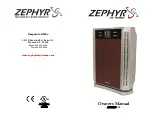
17
Gas
Installation of gas piping must conform with local building codes, or in the absence of local codes to the
National Fuel Gas Code, ANSI Z223.1 (NFPA 54) – latest edition. In Canada, installation must be in
accordance with CAN/CGA-B149.1 for natural gas units and CAN/CGA-B149.2 for propane units.
WARNING: Inlet gas pressure must not exceed pressure indicated on nameplate. See unit
nameplate for proper gas supply pressure and gas type.
1.
Always disconnect power before working on or near a heater. Lock and tag the disconnect
switch and/or breaker to prevent accidental power-up
.
2. Piping to the unit should conform to local and national requirements for type and volume of gas
handled, and pressure drop allowed in the line. Refer to the Gas Engineer’s Handbook for gas line
capacities.
3. The incoming pipe near the heater should be sized to match the connection on the outside of the unit.
Connection size is
1/2”, 3/4”, or 1” NPT
depending on furnace size.
See “Condensation Drain(s)”
Detail A on page 13.
Verify unit inlet size to job-specific sheet.
Avoid multiple taps in the gas supply,
so the unit always has a steady supply of gas.
4. Install a ground joint union with brass seat and a manual shut-off valve external to the unit casing.
Install shut-off valve adjacent to the unit for emergency shut-off and easy servicing of controls.
.
5. Provide a sediment trap, as shown in
, before each unit and where low spots in the pipeline
cannot be avoided.
6. A minimum 1/8” NPT plugged tapping, accessible for test gauge connection, must be installed
immediately upstream of the gas supply connection to the appliance.
7. Clean out the gas line to remove debris before making connections. Purge line to remove air before
attempting to start unit. Purging air from gas lines should be performed as described in ANSI Z223.1-
latest edition “National Fuel Gas Code,” or in Canada as described in CAN/CGA-B149.
8. All field gas piping must be pressure/leak tested before unit operation. Use a non-corrosive bubble
forming solution or equivalent for leak testing. The heater and its individual shut-off valve must be
disconnected from the gas supply piping system during any pressure testing of that system at test
pressures over 1/2 psi. The heater must be isolated from the gas supply piping system by closing its
individual manual shutoff valve during any pressure testing of the gas supply piping system at test
pressures equal to or less than 1/2 psi.
9. This unit requires a constant
7” water column (wc) minimum for natural gas supply
(
LP 11 in. wc
minimum
) when the unit is operating at maximum gas flow. If the gas supply exceeds
14” wc
, it will
damage the internal valve components. If the gas supply drops below
7” wc
(
LP 11 in. wc
), the heater
may not perform to specifications.
for gas pressure type and pressure rating.
High Turndown Furnace
The high turndown furnace will be divided into two separate furnace assemblies within the same cabinet.
This results in a two stage heat source that can stage up and down to meet demand. Since the furnace is
split unevenly, staging on the smallest will result in significantly higher turndown and greater control over
building conditions. An additional Flame Safety Controller (FSC), safety valve, modulating valve, and high
pressure switch (if equipped) will be installed.
NOTICE
Refer to the heater rating plate for determining the minimum gas supply pressure for obtaining the
maximum gas capacity for which this heater is specified.
















































